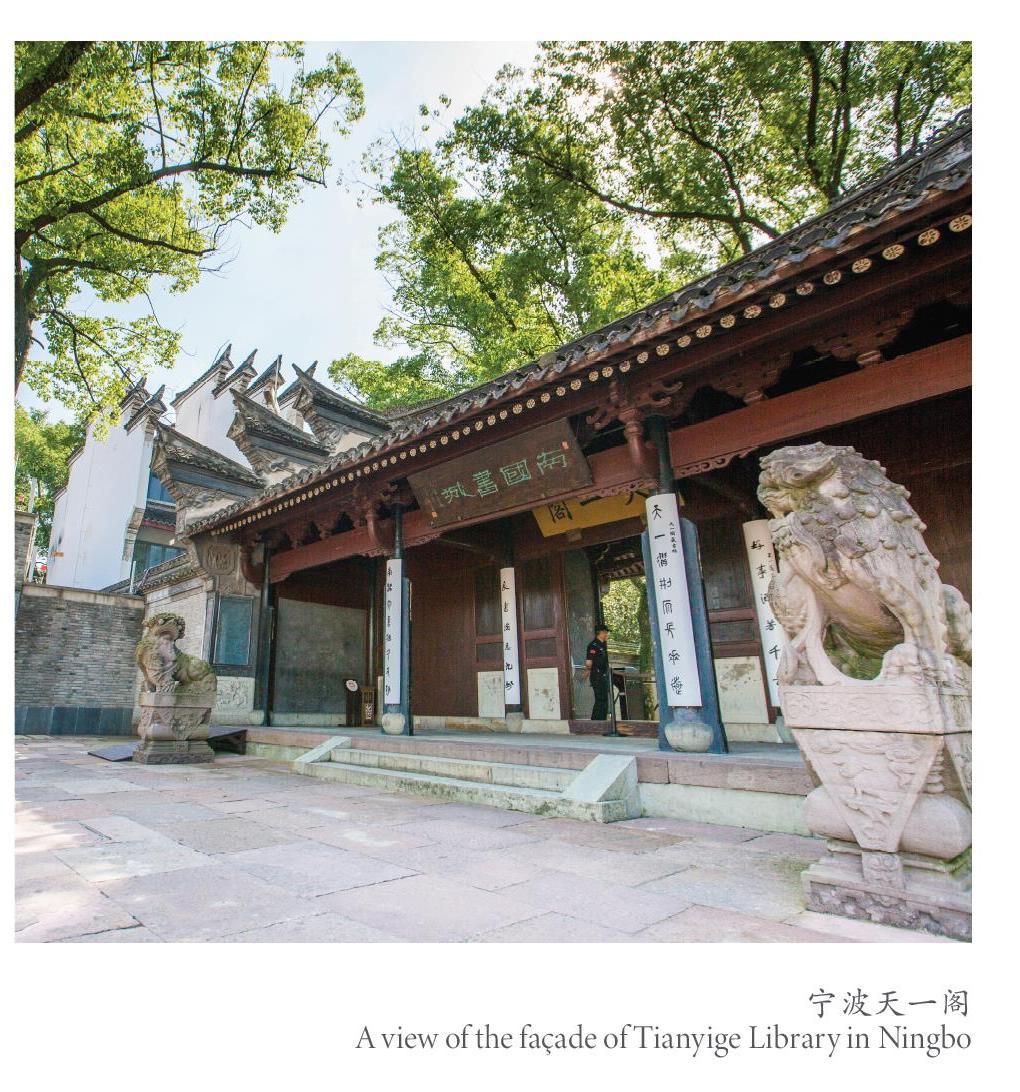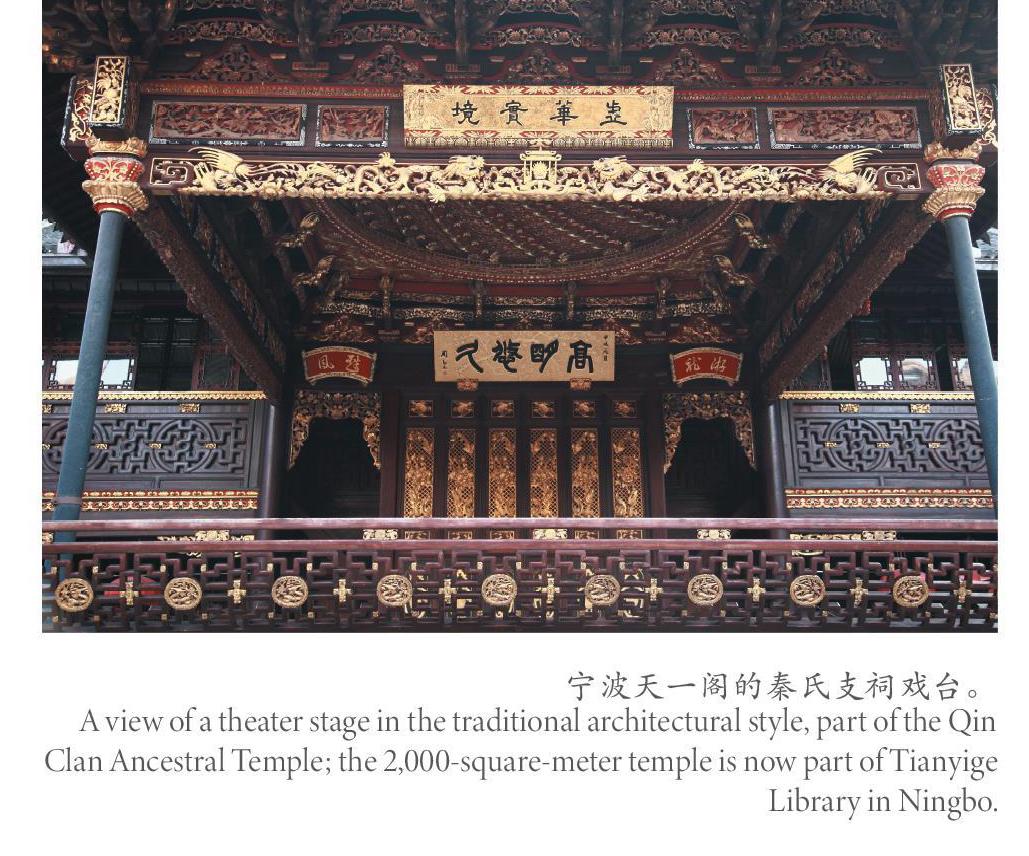天一阁:天一生水 地六成之
2021-03-26



在浙江省宁波市,一座两层藏书楼在此历经了452年的风雨。它与意大利马拉特斯塔图书馆和美国弟奇·洛伦佐图书馆并称为世界上历史最悠久的三大家族图书馆,同时它也是亚洲现存最早的私家藏书楼。
它,便是天一阁。
余秋雨曾在《风雨天一阁》里写道:“它只是一个藏书楼,但它实际上已成为一种极端艰难又极端悲怆的文化奇迹。”
的确,能够屹立至今,天一阁堪称奇迹。
如今,天一阁已经成为以藏书文化为特色的专题性公共博物馆,从一座私家藏书楼变为“南国书城”。数以百万计的中外人士前去参观访问,人们在敬仰中国古代文明的同时,也十分欣赏天一阁对藏书文化的继承和发扬。
清代乾隆皇帝曾高度评价范氏天一阁:珍藏善本丰富,书楼构筑精佳,累世保管有方,嘉惠士林甚伟。他称,范氏天一阁之所以成为藏书界“巨擘”,根本上在于创新和确立了藏书之“制”、藏书之“法”。
范氏十三代人的功绩
一切都得从创建人范钦说起。
天一阁创始人范钦,字尧卿,一字安卿,号东明,浙江鄞县(今宁波市)人。据志书记载,他在嘉靖十一年(1532年)考中进士。初任湖广随州知州。嘉靖十五年(1536年)至嘉靖三十九年(1560年)任職官场,同年十月去官归里。
范钦酷爱书籍,去官归里后建天一阁的时间是在嘉靖四十年至四十五年之间(1561—1566年)。书楼坐北朝南,是一排六开间两层木结构楼房。楼上藏书,各间之间用书橱分隔。楼前有池,楼周围留有空地,与住宅建筑隔开,以利防火。他晚年时认为“书不可分”,藏书便由其长子范大冲继承,大冲因而放弃了其他的家产。
范大冲字少明,他继承父志,续增藏书,刻范钦所著《天一阁集》,规定藏书归于子孙共同所有、共同管理。从此,子孙各房相约,凡阁门和书橱门的锁钥分房掌管,非各房齐集,不得开锁,从制度上保证了书籍不被分散。
大冲子汝楠,字公定,一字梁甫,号九如,府学生,入国子监。汝楠长子光文,字耿仲,号潞公,清顺治六年进士,授礼部主事,迁史部文选司,八年为陕西试正考官,曾在天一阁前增构池亭,环植竹木。汝楠次子光燮,字友仲,一字鼎仍,晚号希圣老人,恩贡生,康熙十五年(1676年)为嘉兴府学训导。他从天一阁传抄书籍百余种,供士子们阅读,并导黄宗羲登阁,提高了天一阁在学术界的知名度。
光燮子正辂,字载瞻,康熙五年举人,曾任秀水教谕,泉州德化县知县,湖广郧阳府通判,他与光文、光燮一样,对天一阁藏书亦有增益。至乾隆三十八年(1773年),范钦八世孙范懋柱代表范氏后人进呈了一批典籍,供四库全书馆采用,支持了《四库全书》的纂修,因而得到了一部内府铜活字本《古今图书集成》一万卷的嘉奖。道光九年(1829年),范筠甫、范邦冉等范氏后人于节省杞田之余,竭尽全力,对藏书楼进行了一次大修,同时还修订了管理制度。
咸丰十一年(1861年),太平天国军队进驻宁波前后,盗贼乘混乱之机,破培入阁,潜运藏书,此后辗转流散。范钦十世孙范邦绥“方避地山中,得讯大惊,即间关至江北岸。闻书为洋人传教者所得,或卖诸奉化唐岙造纸者之家,急借贷赎回。寇退,又借宗老多方购求,不遗余力,而书稍稍复归”。邦绥字履之,号小酉,为咸丰六年进士,四川即用知县。
清末民初,一些藏书之家以为废科举兴学校古籍已无用,便陆续将书籍出售。如曾与天一阁鼎足而立的宁波藏书家郑氏二老阁和卢氏抱经楼,均先后被变卖一空。而范氏后人顶住了书商的利诱,经受住了物质利益的考验,抱残守缺,把藏书保存下来。
1949年新中国成立前后,守阁的有范钦十二世孙范盈性和十三世孙范鹿其。他们默默无闻地管理着遗存的原藏书1.3万卷和《古今图书集成》8200余卷。由于天一阁主人十三代人的努力,天一阁终于跨越了四百多个春秋,开创了中国文献保存史上的奇迹。
书楼俱存 世所罕见
从范氏故居向东,走过巷弄,眼前出现的二层建筑便是天一阁藏书楼。天一阁又名宝书楼。这是因为在二楼正中的上方,悬挂着明代隆庆年间宁波郡守王原相所书的“宝书楼”匾额,后人就沿袭了这个称呼。
为何这座二层小楼如此受器重?它又如何历经沧桑成为典范?
历史上,天一阁经历了多次劫难,特别是抗日战争期间,为躲避战火而进行了大规模书籍转移。这一时期,所藏珍本向外转移,共分3批,转移了5次。第一批于1937年8月先移至月湖碧沚祠,后转至鄞西眺头范家庄。第二批于1939年1月移存鄞南茅山范钦墓庄。最后一批包括前两批一起于1939年4月转移到浙南龙泉。1943年1月又从龙泉转移到庆元。直到抗战胜利后,这些珍贵书籍才回到阁中。
在经历了鸦片战争、太平军攻陷宁波、盗贼偷盗等一系列外忧内患的劫难后,天一阁中的藏书一度散失。但明清以来的历届政府与文人墨客都对天一阁爱护有加,许多藏书家先后将珍藏图书捐赠给天一阁。目前,阁中现藏各类古籍近30万卷,其中珍椠善本8万余卷。虽然目前流传下来的范氏原藏书仅1.3万多卷,还不到原来的五分之一,不过,相对于明清以来其他著名藏书楼,天一阁能一直传承下来,已经非常幸运。
1940年,日军侵犯宁波之前,范氏后人在浙江图书馆和鄞县文献委员会工作人员的协助下,把全部藏书分装二十三大箱,用卡车转移至浙南山区龙泉县,租屋存藏,范氏推定范召南会同管理。1945年8月日本投降,次年冬,藏书运回归阁,在阁内公开展出数天。
天一阁曾经历了两次大修。清道光九年(1829年),由范氏族人范邦冉等对天一阁进行大修,“上自栋瓦,下至介庭,左右墙垣,罔不焕然一新”。再次大修则是由民国时期冯贞群、朱鼎煦等宁波文化界热心人士共同募资完成,共同参与维修,并在大修期间做好书籍保护工作。这一次重修的过程中,还将尊经阁连同当地保存的80余方历代碑石移至天一阁后院,并将尊经阁前的庭院命名为“明州碑林”。
天一阁藏书流传至今,书楼俱存,世所罕见。这与天一阁建造时所用的巧妙心思密切相关。范钦从政期间,积极参与藏书过程,参加交流活动,直接了解和总结当代藏书楼营造的案例和经验。范氏天一阁把藏书、建筑、园林结合起来,重在因凭选址、拟象构筑、审美造境,以其独到的书楼营造文化为支柱。
天一阁外观为上下两层。楼下广宽六间,进深六间,以木板隔断,既分切又组合,左有楼梯,右为书房,中间是宽敞的明堂,各具交通、研读、会友的特定空间功能。楼上是一大统间,进深压缩为四间,以中间松木脚杉木板的专用书橱集群隔一而为六,收藏文献典籍、碑帖字画和刻书印版。前后檐相交暗建三层,各间设四扇推拉木槛窗,博脊和檐椽之间装有铁栅栏,既强化通风,又防范盗窃。下六上一的室内构成,直接照应了《易经》郑注“天一生水、地六成之”的说法,蕴含以水制火、火为水克和火生万物、万物水润之义。书楼因而以“天一”命名。
书楼以山水、花木、建筑的组合构成为本质特征的园林,是建筑的变异类型,或者说是建筑体系的一个组成部分。浙江私家藏书楼崇山乐水,写意抒怀,情景交融,人境合一,再创藏书有意味的文化时空和审美境界。范氏天一阁发挥了易道文化,促进了藏书文化、建筑文化、园林文化的结合,丰富和发展了易道文化审美造境的书楼营造文化。
值得一提的是,范钦在阁前凿池蓄水防火,池水与月湖相通,完全体现了“天一生水”之义。山下山上林木森郁,丛竹摇曳,一派山野风光,自然天成。
“南国书城”大发展
与一般藏家不同,范钦的收藏侧重在明代实录、科举录、地方志、政书、碑帖丛帖以及先辈未传世的诗文集等方面。每到一地,范钦都留心收集,尤其重视收集当代人的著作,像《国子监监规》《武定候郭勋招供》之类的官书,是当时的内部资料,为一般藏书家所难以收得的。后来,他购进丰氏万卷楼的一部分藏书,又与友人相约互抄书籍,藏书数量大大增加,如今已成为研究明代政治、经济和文化的重要资料。
1949年6月9日宁波军事管制委员会文教部接管了范氏天一阁。从此,天一阁进入公藏时期,范氏后人范盈性和范鹿其也成为公职人员,其后,天一阁藏书迎来了大量扩增。由于天一阁成了国家的一个文化事业单位,宁波许多著名藏书家先后把自己珍藏多年的图书、绘画、碑帖等文物捐献给天一阁收藏。
天一閣现藏古籍30余万卷,其中善本8万余卷,文献资源较为丰富,重点保存了明清两代的刻本和抄本。地方志、科举录、家谱、地方文献颇具特色,已经具备研究级文献单位的条件。藏书家们为保存祖国文化遗产,都花去了不少精力和财力,这一批批古籍都凝结着他们的汗水和辛劳:有的节衣缩食,经、史、子、集、兼收并蓄;有的批校题跋,长年累月以此为乐:有的在战乱的环境里,不顾个人安危,跟随图书颠沛流离。
他们把藏书化私为公,为保存和弘扬中华民族优秀的藏书文化作出了无私的奉献。
天一阁进入公藏时期以后,就具有公开性的特征,其管理也逐渐开放。新中国成立以来,由于藏书的成倍增加,书楼已无法容纳,读者和观众大量增加,原来的场地也显得狭小。随着天一阁藏书文化的延伸和发展,天一阁管理部门围绕天一阁提出了“南国书城”的构想。
天一阁书城建设构想是在旧城改造大规模进行的历史条件下提出来的,天一阁管理部门依靠北京历史建筑研究所和宁波市规划局的专家们绘制规划图。在一年多时间里调查研究,三易其稿,于1994年1月5日经市规划会议论证通过。
全部工程将分三期进行。1994年,当地政府决定三年内拨款一千五百万元。浙江省石油公司宁波分公司、宁波市外经贸委所属企业、宁波开发区华能公司等十余家企业也热情资助,至1995年2月,赠款总额已超过二百万元。
一期工程实际启动时间是1993年初,当时国家计委已拨款七十万元,用于拆除紧邻天一阁西墙的一千余平方米旧房。如今,三祠已经修复,六十余户居民和一家医药仓库已动迁完毕,书城建设图景已然成为现实。
天一阁也由单体保护延伸为群体保护,成为展示中国古代民间藏书文化最丰富的书城。这不仅具有地方意义和全国意义,而且具有世界意义。
Tianyige Library in Ningbo
The Medicean-Laurentian Library and the Malatestiana Library in Italy and Tianyige Library in Ningbo, a harbor city in East Chinas Zhejiang Province, are known as the three extant ancient family libraries in the world. The 452-year-old Tianyige is the oldest extant private library in Asia.
Yu Qiuyu, a modern essayist and scholar, once commented that Tianyige is more than a library and that it is a cultural miracle that has survived extreme challenges and saddening years. Today, it is a public museum that has received millions of domestic and international visitors. Emperor Qianlong of the Qing Dynasty who reigned from 1735 to 1796 spoke highly of Tianyige for its choice collection, well-designed library structure, perfect management system, and benefits the library brought to scholars.
Tianyige was founded by Fan Qin, a native of Ningbo. A Jinshi from the imperial examination in 1532, he worked for the government from 1536 to 1560. The library was erected from 1561 to 1566. The two-story wood structure was especially designed as a private library. It has a pond in front of the building and stands alone from the living quarters on the compound. The book storage space on the second floor is compartmentalized, separated by book cabinets. The design aimed to prevent fire from catching on.
In his evening years, Fan Qin believed the collection should never be divided equally by his sons and decided to leave it to the care of his first son Fan Dachong and bequest other properties to his other sons. Fan added new books to the collection, signed an agreement with family members and installed a management system. According to the system, the collection belonged to the family; keys to the door of the library and to the book cabinets were kept by family members separately; no one could access the library without the presence of family representatives with the keys.
Fan Dachongs son Fan Runan studied at the Imperial Academy. His first son Fan Guangwen was a Jinshi and worked as a government official. His second son Fan Guangxie began to work at the education department in 1676 in Jiaxing in northern Zhejiang. He copied more than 100 books from Tianyige and checked them out to students. He welcomed Huang Zongxi to read books at Tianyige, greatly enhancing the reputation of the library among scholars. Fan Guangxies son Fan Zhengluo added books to the family collection.
In 1773, Fan Mozhu, the eighth-generation descendant of Fan Qin, donated some books on behalf of the Fan family in Ningbo to the central government for the use of the Siku Quanshu, the complete imperial collection of books in four branches being compiled at the edict of Emperor Qianlong. The Fan familys contribution was recognized by the central government. The family received a set of 10,000-volume books printed with copper movable-types as a reward. In 1829, the Fan family had Tianyige refurbished and the management rules modified.
Tianyige suffered a heavy blow in 1861 when soldiers of Taiping Heavenly Kingdom were besieging Ningbo. Some thieves broke in and stole a great number of books.
Fan Bangshui, a tenth-generation descendant of Fan Qin, learned about the theft and hurried back from his hiding in a bid to retrieve all the lost books. He soon learned that some books were in the possession of foreign missionaries and some had been sold to paper makers in Fenghua. After the soldiers of the Taiping Heavenly Kingdom withdrew, Fan Bangshui raised funds and bought back the lost books.
In the last years of the Qing Dynasty (1644-1911), the imperial examination system was abolished and new schools were introduced. Some book collectors in Ningbo thought ancient books were outdated and began to sell books from their private libraries. Two famed private libraries sold their collections and sold themselves out into historical oblivion. The Fan family held fast to the family library. During World War II, the books were transferred to safety five times from August 1937 to January 1943. They returned to Ningbo in the winter of 1946.
When the Peoples Republic of China was founded in 1949, Tianyige maintained 13,000 books of the original collection and 8,200 books of the 10,000-book set from the Qing government. On June 9, 1949, the local government took the library under wing and Fan Yingxing and Fan Luqi, two members of the Fan Family were put in charge of daily administration of Tianyige.
After the birth of the Peoples Republic in 1949, Tianyige became a government cultural institution better protection. Many private collectors found Tianyige ans a government institution trustworthy and donated generously to the ancient library.
At present, Tianyige has a collection of 300,000 ancient books including a wide range of local annals, documents, family pedigree books, imperial examination records.
The expanded collection called for a large space for storage. In the middle of the 1990s, the library compound expanded with funds donated by local businesses and allotted by Ningbo City and the central government. Over 60 households moved away and a pharmacy business vacated an adjacent warehouse to make room for the expansion. The expansion project in the 1990s was the third one in the history of Tianyige.
The first overhaul project took place in 1829. The second occurred in 1933, with funds raised by local people. In 1935, Zunjing Pavilion in Ningbo was relocated to the compound of Tianyige. Also relocated to the compound were over 80 historical stone steles.
